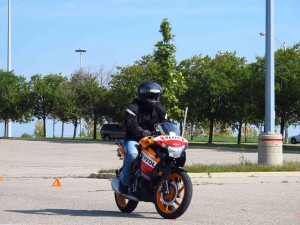10 Things to Consider Before Learning to Ride
by Liz Jansen
 With adventure genes coming to life in what seems like record numbers of women and men, I’ve received many requests, wondering how to get started with riding.
With adventure genes coming to life in what seems like record numbers of women and men, I’ve received many requests, wondering how to get started with riding.
Ultimately, it boils down to safety. Your skills, the road, the elements and other drivers make you vulnerable. You’re in control of your choices so take the time to make well-informed decisions before learning to ride, even if it takes longer to get started.
Although they’re geared to motorcycling, these ten considerations are generic enough to apply to whatever is calling you.
- Reason for wanting to learn. If it’s because in your heart this is something you really want to do, then you’ll find a way. If you’re considering it only because someone else wants you too, then stop right now. It will never work. You won’t enjoy it and you risk harming yourself or someone else. Besides, there will be something else that does fit you better and you’re missing out on that while doing something you have no desire for.
- Cost of a motorcycle. Whether you buy new or previously owned (strongly advised for a new rider), there is a significant cash outlay. Consider not only the initial purchase price but also any customization you may need/want, accessories – like saddlebags, gas consumption, storage, maintenance (more below). Thankfully, it doesn’t all need to be done at once.
- Cost of gear. Good quality gear is a must for safety. You will likely pay more for something that combines function, fashion and fit. You’re worth it! At a minimum you’ll need boots, an abrasion resistant jacket, gloves, helmet and preferably riding pants. While you can get by with the basics to get started, you’ll also want to add rain gear and riding gear suitable for different weather conditions.
- Insurance. Shop around. There is considerable variation between insurance companies. Factors that influence the price, and sometimes even availability, include your age, experience, rider training courses, driving record, model type, size and year.
- Maintenance. Motorcycles are mechanical and need routine and periodic maintenance. While it’s fun, convenient and easy to do some of it yourself, not everyone has the interest, tools or space to do so. Shop time can easily run close to $100/hour and since good mechanics are hard to find, you may have to wait — not a nice thought when you’re ready to go on vacation. Research the cost and availability of replacement parts, especially on used bikes.
- Companionship: Initially, it can be daunting to try something that no one in your family or social circle participates in. Eventually you’ll meet like-minded others and a whole new world will open for you.
- Storage. Ideally, motorcycles should be stored indoors. At minimum, they need to be kept covered when not in use. In most of Canada and much of the US, winter weather precludes us from riding. Unsheltered winter storage is hard on bikes and to be used only as a last resort.
- Training. A must in my books. Take a certified course, taught by qualified instructors. While partners, family, friends mean well, their emotional attachment can interfere with your learning. And even if they’ve taken the course themselves, they lack the expertise to train someone else.
- Location: While big city living has its conveniences, it also has drawbacks. Riding in rush hour traffic or a busy downtown is not fun and much riskier than the open road. Getting to those scenic back roads that are meant for riding can be a challenge. You may need to start at off-peak times or find a friend who resides in a more suburban or rural setting and will let you park your bike there.
- Time: You need to ride to keep your skills sharp. It’s also better for your bike. If you don’t have the time, then perhaps its better to wait a season or two until you do.
Riding is an exhilarating, freeing and rewarding experience. But there’s too much at risk to take it lightly or rush into. Take the time to do your homework. Even if you have to wait a little longer before taking the plunge, it will pay off in safety and enjoyment.

Random thoughts – The 2 day MSP class is a must IMO. It will let one know if it is something they really want to do. Not everyone has the coordination, strength, balance required. Also seriously consider where you want to ride and when. Riding partners are a plus especially if they are experienced. Re. storage, when not being ridden, plug in the battery tender (is that what you call it?). First bike ever? Buy used.
All good points. Here in Ontario, many of the courses, including the one where I teach, offer a 4 hour introductory course that also gives people a chance to test if it’s something they want to continue with.
Thanks David.
Liz
I forgot to mention that as a returning rider the class was worthwhile. Learned some new things and refreshed old stale skills. More confident rider after the class. There were two other returning riders in the class, both 72. I ride the backroads in the Sierra so the only real hazards to watch for, besides logging trucks and sight seeing RV’s, are deer. It seems deer can come out of nowhere with no warning.